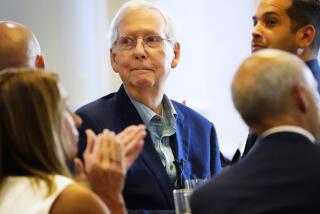No Need for Dr. Death
- Share via
On separate shows, prime time Sunday night television audiences viewed a graphic display of the two generally accepted means of coping with a major physical disability: death or cure. The first segment, on CBS’ “60 Minutes,” was a horrific videotape depiction, for the first time, of the fatal injection of someone, in this case a man with Lou Gehrig’s disease. The controversy aroused by this disgusting presentation focused primarily on the morbid theatrics of Jack Kevorkian, who was charged Wednesday with first-degree murder and other crimes in connection with the videotape, and also on whether such a death of anyone should appear on TV.
Little media attention was devoted to the real physical or mental condition of the victim or to the broader question of how many of Kevorkian’s previous subjects were not terminally ill patients but simply women and men with disabilities.
The second program, on ABC, featured Christopher Reeve, a quadriplegic and an established celebrity, in a remake of the classic drama “Rear Window.” This fictional portrayal was a largely accurate account of the remarkable range of occupational and recreational activities that can be performed with assisted technology and personal attendants. It also portrayed the enormous financial cost of living with a significant disability. Yet Reeve’s struggle to master his surroundings was repeatedly punctuated by expressions indicating that the principal activity of his life was waiting and hoping for a cure. Many other disabled persons regard this attitude as offensive.
Both of these spectacles, therefore, reinforced and endorsed the view that death or a cure are the major methods of dealing with a disability.
What television failed to show Sunday and indeed on most other occasions is a another approach engaged in by millions of other disabled men and women, including myself, everyday: We simply go about our lives. Many of us have experienced the depression that often accompanies a major change in routine functions, but we are outraged by Kevorkian’s proposal that suicide is an appropriate solution to the obstacles that we confront. Nor do we agree with Reeve’s character in “Rear Window” in making our lives contingent upon the desire for a cure. We derive meaning and purpose from our lives as they are lived, in work and leisure, just as others do.
A growing number of us understand that the barriers we confront exist in the external environment rather than in bodily impairments. In surroundings like Reeve’s state-of-the-art apartment in “Rear Window” there would be little justification for Kevorkian’s macabre plan. We may have to bear heavy economic expenses to pursue our lives until the environment is adapted to grant everybody equal status in society. But we realize that many of our problems can be solved by social and political changes to end discrimination rather than in death or the quest for a cure.
In addition, many of us realize that, like other groups that have resisted oppression, citizens with disabilities are a minority entitled to the same opportunities, dignity and respect as others. Certainly, the general public would be outraged if TV transmitted the death of members of other minorities who felt life was not worth living because of the prejudice and suffering they were forced to endure.
I frequently shudder when I think about the prescription that Kevorkian might have sought to offer me 53 years ago when the physicians who diagnosed my case of polio predicted that I would “lie flat on my back for the rest of my life.” But I have not spent my time contemplating suicide or in a unremitting search for a cure. I have a wonderful job and a loving relationship. My partner also was told 19 years ago, when she had a brain aneurysm, that her only options were death or existence as a vegetable; but she regained the ability to talk, to walk, to think and to participate in a wide range of activities.
Neither of us believes in miracles. And both of us are extremely frightened that the public death of individuals with disabilities might gain widespread or routine acceptance. Meanwhile, we intend to reject Kevorkian’s solution by pursuing life. And sometimes we even try to resist the apostles of death simply by having fun.
More to Read
The complete guide to home viewing
Get Screen Gab for everything about the TV shows and streaming movies everyone’s talking about.
You may occasionally receive promotional content from the Los Angeles Times.






